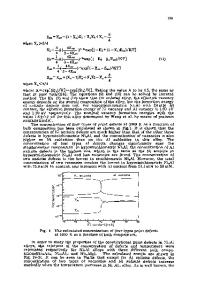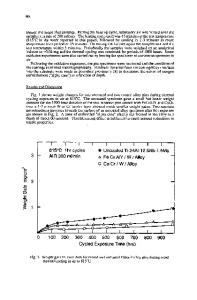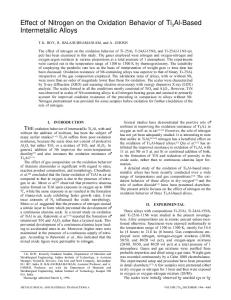Diffusion of Au in the Intermetallic Compound Ti 3 Al
- PDF / 554,904 Bytes
- 8 Pages / 593.972 x 792 pts Page_size
- 17 Downloads / 408 Views
0011-2 Ó The Minerals, Metals & Materials Society and ASM International 2009
I.
INTRODUCTION
THE a2-Ti3Al intermetallic compounds have been developed as promising lightweight heat-resistant structural materials for the last 20 to 30 years, and a great deal of research has been done on their high-temperature strength and oxidation behavior.[1,2] Recently, Ti3Al has attracted attention for possible use as a conductive diffusion barrier in microelectronics devices such as ferroelectric random access memories.[3–5] Therefore, diffusion data of elements contained in integrated circuits are increasingly important. Ru¨sing et al.[6] have measured self-diffusivity of Ti and interdiffusivity in binary Ti3Al. Although the diffusivities of some impurity elements contained in Ti3Al alloys for high-temperature structural application have been measured,[7] only limited data are available for diffusion of constituent elements of electrics devises; the diffusivities of Si and O have been measured by Koizumi et al.[8,9] and that of Ga, by Herzig et al.[10] Further study for diffusivity of elements used in electronic devises such as Au, Ag, and Cu is desirable to understand the implications for device reliability. On the other hand, it is well known that diffusion in intermetallic compounds is dominated by complicated mechanisms due to their ordered structures. Ti3Al has the D019-type ordered structure, which is based on the hcp structure (Figure 1(a)). It has been anticipated that the diffusion mechanism is affected by the ordered arrangement, because each Ti atom has 8 Ti atoms and Y. KOIZUMI, Assistant Professor, and Y. MINAMINO, Professor, are with the Department of Adaptive Machine Systems, Osaka University, Osaka 565-0871, Japan. Contact e-mail: [email protected] T. TANAKA, formerly Graduate Student, with Department of Adaptive Machine Systems, Osaka University, is with Hitachi Limited, Tokyo 100-8280, Japan. Manuscript submitted January 8, 2009. Article published online October 14, 2009 METALLURGICAL AND MATERIALS TRANSACTIONS A
4 Al atoms as the nearest neighbors (Figure 1(b)) while each Al atom has 12 nearest-neighbor Ti atoms (Figure 1(c)) in fully ordered Ti3Al. The same nearestneighbor coordination is present in the L12-type ordered structure of Ni3Al, Ni3Ga, and Ni3Ge, for instance.[11] In this context, the mechanisms of self-diffusion in Ti3Al have been proposed by Mishin and Herzigh.[12] From experiments on impurity diffusion in Ti3Al, it has been found that elements with a comparatively small atomic radius (r) such as Fe (r = 0.127 nm) and Ni (r = 0.125 nm) exhibit fast diffusion by the dissociative diffusion mechanism where they pass through the interstitial octahedral sites, whereas elements with a relatively large atom size such as Nb (r = 0.147 nm) and Ga (r = 0.141 nm) exhibit relatively low diffusivity.[7] However, the diffusion of impurity atoms in intermetallic compounds depends not only on the size of the impurity atoms but also on the impurity sitesubstitution behavior. For instance, in Ni3Al with L12-type ord
Data Loading...











